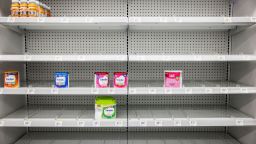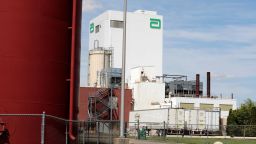It has been a year since a major formula manufacturing company recalled several products, which escalated a widespread shortage in the United States and evoked fear in parents and caregivers nationwide.
By some measures, the acute shortage is mostly resolved; data from market research firm IRI shows that stock rates have been back near pre-shortage levels for months. But for many families with newborns and others who rely on formula, it doesn’t feel that way.
“In the early months of the shortage, it was absolute desperation,” said Hannah Kroll, whose second child turned 1 in July.
Last spring, after struggling to find formula herself, Kroll launched a Facebook group to help connect others in need. The group – Baby Formula Search and Swap: Parents Helping Parents – still has thousands of members and multiple posts each day, and there are many others like it.
The desperation has eased some, but caution remains, Kroll said.
Find My Baby Formula, a tool that monitors formula stock and sends notifications to users when it’s available, is still getting new sign-ups every day.
Ken Bean, the programmer behind it, wanted to help others who were having trouble finding formula like he was after his son was born in April. He said he hoped the site would last two or three months, but about 5,000 people still visit each day. That’s down from a peak of about 12,000 visitors a day – perhaps a sign that things are getting better but aren’t fully resolved.
Ongoing challenges
The formula shortage reached a head in July, when more than 20% of all formula products – including more than 30% of powdered formulas – were missing from store shelves, according to IRI data. By then, Abbott Nutrition had just reopened its manufacturing plant after months of stalled production and Operation Fly Formula, the Biden administration’s plan to boost supply with imported formula products, had completed only about half of its missions.
Stock rates steadily improved over the following months and had nearly returned to typical pre-shortage levels by October. But survey data from the US Census Bureau, first published that month, found that a large share of families were still struggling.
In the months since, IRI data shows stock rates have held steady at relatively normal levels. But the share of US families who say they are struggling hasn’t budged, either.
In January, as in October, about a third of families with an infant younger than 1 said they had had trouble getting formula sometime in the past week. More than half said they had less than a week’s supply on hand.
The White House does not use the Census Bureau’s survey data as a benchmark, noting that there is no baseline to compare experiences before the shortage and that other indicators suggest the situation has vastly improved.
Bare shelves in the formula aisle of the grocery store are a less common sight than before, but many retailers are still limiting purchases.
“While we are seeing continued improvement in baby formula, we are still seeing impact from the recall and factory shutdown in 2022,” a Kroger spokesperson told CNN. “To ensure all customers have an opportunity to purchase formula, Kroger is asking customers to limit their purchases to four formula containers.”
And the US Food and Drug Administration acknowledges the ongoing challenges.
“We recognize that while infant formula supplies are improving, there are still parents struggling to find formula or find their specific type of formula on store shelves. We continue to do everything we can to make sure parents can get safe and nutritious infant formula whenever and wherever they need it,” an FDA spokesperson said.
Lingering emotional effects
Fear and worry are also heightened for parents who have been hearing about the shortage for a year, perhaps making the situation feel worse than the data suggests it is.
Experts say the emotional effects of the shortage will linger long beyond the economic impact. A level of worry may persist even if the broader circumstances have changed.
“It’s terrifying to think that you aren’t going to be able to nourish your infant,” said Lauren Bauer, a fellow with the Brookings Institute whose research focuses on federal nutrition assistance programs. “If you see a single hole on a formula shelf when you go, you remember that.”
Respecting individual experiences and managing fears amid the market changes is a critical part of the crisis, Bauer said.
“If there’s this huge gap between reality and families’ fears, then more needs to be done to convince families that the crisis is over,” she said. “Families need to know that steps are being taken to prevent similar crises in the future and that they will both have sufficient resources to get the formula that they need and that they will see the thing they intend to purchase when they go to the store. No surprises.”
The formula market is typically very stable, in large part because a steady birth rate in the US leads to a steady demand, said Krishnakumar Davey, president of client engagement at IRI.
But after a supply shock like this, it typically takes markets at least six months and up to a year to recover, Davey said. The unique nature of the formula market could affect consumer behavior, too.
The question in the Census Bureau’s Household Pulse Survey about “difficulty obtaining formula” is broad, leaving room for interpretation for the cause of that difficulty.
Experts say that financial constraints are probably not a driving factor, though.
Most formula in the US is purchased with benefits from the Special Supplemental Nutrition Program for Women, Infants and Children, known as WIC. State contracts determine which brands and sizes are eligible for purchase with these benefits, and the federal government expanded the range of options available to families during the shortage.
“You are fully resourced if you have WIC to go and get the formula. But if the formula isn’t there, that’s the problem,” Bauer said. “There’s no financial constraint for those families in terms of formula, it’s just about access.”
Federal data shows that WIC coverage rates, the share of the eligible population that actually enrolls in the program, held steady between 2019 and 2020 – a signal that the Covid-19 pandemic did not particularly deter sign-ups for the program.
“If people didn’t have WIC, these [Census Bureau survey] numbers would be enormous,” said Geri Henchy, director of nutrition policy at the Food Research and Action Center, an advocacy group.
But there are lots of factors that could affect access to formula, experts say, many that may have existed long before the shortage started.
The federal government does not collect centralized data on redemption rates, so there’s no national picture to track how often WIC enrollees use their benefits and how that may have changed over time.
Millions of Americans have limited access to large food stores, with food deserts more prominent in some parts of the country than others. Food insecurity tends to be higher for younger families, too.
Plus, navigating the formula aisle is complicated in general. Once a baby starts on a specific type of formula, families don’t always know which options are appropriate substitutions for their child, if any.
And a year after the recall, a whole new group of families is starting to learn all of this from the beginning.
Get CNN Health's weekly newsletter
Sign up here to get The Results Are In with Dr. Sanjay Gupta every Tuesday from the CNN Health team.
“We’re going into the second year of this, so we have a whole new generation – a whole new cohort – of parents who are dealing with this,” Kroll said. “It’s a whole new group of moms that we’re helping through the groups that we created for the initial group of babies who were affected.”
In December, the US Department of Agriculture sent a letter to state agencies outlining a plan to “unwind” and transition back to regular operations, cutting back on waivers that had been extended during the shortage.
“They must be seeing something to give them some confidence that the prior status quo can be returned to,” Bauer said.





